Administered Item naming
Logical name
When the add-on creates Administered Items from a data model, their logical names are set automatically. Depending on the type of the Administered Item, the logical name is based on one of the policies described below.
Administered Item | Data asset types (Logical data types) | Rules applied to fulfill the default name automatically | Examples |
|---|---|---|---|
Data Element | Data value | 'D.E.C. name' - 'Value Domain name' | Person-name-String Person-age-Integer |
Data Element Concept (D.E.C.) | N/A | 'Object Class name' - 'Property name' | Person-name Person-age |
Object Class | Table | Logical name of the table as known to EBX® | Person |
Group of fields | Logical name of the group as known to EBX® | MyGroup | |
Complex Type | Logical name of the complex type as known to EBX® | Address | |
Domain | Logical name of the group as known to EBX® | Root | |
Property | Field, Association | Logical name of the field as known to EBX® | name age linkProduct |
Value domain | Data Type | Name of the data type as known to EBX®. When the data type is an enumeration the postfix [Enumeration] is added | Integer String |
Special notation: | |
|---|---|
| The modification of an Administered Item's logical name is forbidden since it represents the link with the underlying data model. However, it is possible to display a 'Universal name' instead of the logical name (see the next section). |
In the example below, a unique 'age' property is created since the logical names of the fields are exactly the same. From a governance point of view, the 'age' property is described by itself, and each 'age' field related to a table is also described through Data Element Concept names.
This ability to unify the 'age' definition enables metadata optimization. With help of the 'Data Element Concept name' it is possible to provide an additional definition of 'age' in the context of every table.
Special notation: | |
|---|---|
| You can deactivate the de-duplication process (see previous section). A configuration property determines whether de-duplication is active or inactive. |
Table logical name | Field logical name | Property name | Data Element Concept name |
|---|---|---|---|
Customer | age | age | Customer-age |
Employee | age | Employee-age |
In this second example, the logical names of the fields are different. This means that two different properties are created. It is no longer possible to create a shared definition for the concept of 'age'.
Table logical name | Field logical name | Property name | Data Element Concept name |
|---|---|---|---|
Customer | age | age | Customer-age |
Employee | Age | Age | Employee-Age |
In the UI governance repository, when properties have the same name with different case, then a suffix is added to distinguish them. This suffix is the property identifier. For instance, in the example above, the display can be 'age[111]' and 'Age[123]' considering that '111' and '123' are the related identifiers.
This naming convention is also used when the de-duplication process is deactivated in order to distinguish between Administered Items with same logical name.
Universal name
At times an Administered Item's 'Logical name' may lack enough context to make it truly useful. However, due to its required link to the underlying data model, you cannot modify the 'Logical name' property. The 'Universal name' property can fill this gap by providing additional information that enriches the item's context.
Upon automatic item creation, the 'Universal name' inherits from an item's 'Logical name' property. However, you can override this value to use a 'Universal name'. This naming convention holds true for automatic creation of D.E.C. (Object class — Property) and Data Element (D.E.C. — Value Domain) composite Administered Items. Take for example, the D.E.C. illustrated below.
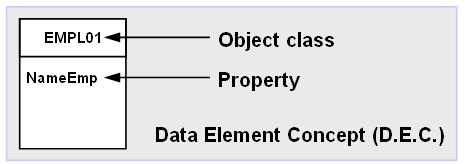
The table below shows default naming applied by the governance repository for the 'EMPL01' table and 'NameEmp' field. Additionally, it shows the result of enriching the information manually, or by using the built-in 'Reset' option. The following sections discuss these methods in further detail.

Updating the 'Universal name' applied to atomic Administered Items
The following example shows an Administered Item that is a type of 'Property'. By default, the 'Universal name' inherits from the 'Logical name'.
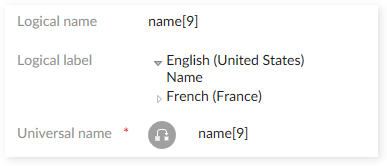
To provide additional information, click the small gray icon next to the 'Universal name' property to overwrite inheritance and enter a new name.
Updating a 'Universal name' applied to composite Administered Items
The following example shows a D.E.C. which is a type of composite Administered Item based on an Object class and a Property. As shown below, the 'Universal name' inherits from the 'Logical name' of the two related Administered Items.
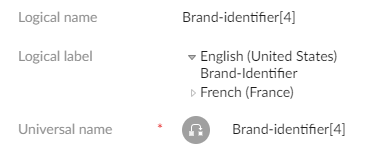
You can click the 'Reset' button to override default behavior and automatically compute the 'Universal name' based on the composition of the Administered Items' 'Universal names'. In this example the 'Brand-Identifier' Data Element Concept 'Universal name' is 'Brand-identifier[4]'.
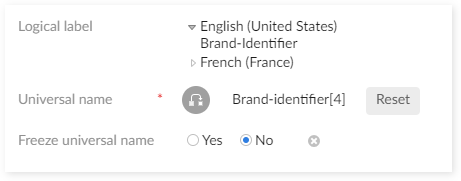
Alternatively, you can manually override both types of inheritance and customize the 'Universal name'.

Special notation: | |
|---|---|
| You must provide a universal name when manually creating administered items. It is part of the process of governance repository optimization. |
| Like the logical name, the universal name is not localized by language. Indeed, the universal name is a business translation of the logical name into a meaningful term. To provide names and definitions by languages, the "Definition" tab is used. The definition is done by languages and any other types of contexts. |
Logical label
The logical label is retrieved directly from the logical data model. It is displayed for information only on the Administered Item's main display tab. It is also the information attached to the DMA context in the 'Context naming definition' tab.
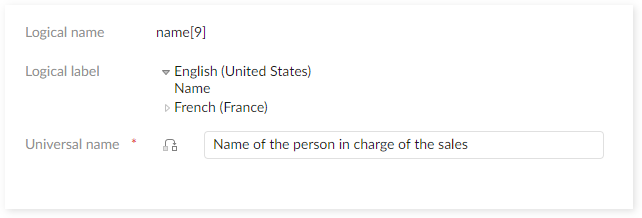
Selecting the type of item name for display
The data hierarchy views and other parts of the add-on repository UI can be configured to display either an Administered item's 'Logical name', 'Universal name' or 'Logical label'. By default, the 'Logical label' is used.
You can refer to 'Configuring user preference' section to see how to select the type of name to display.